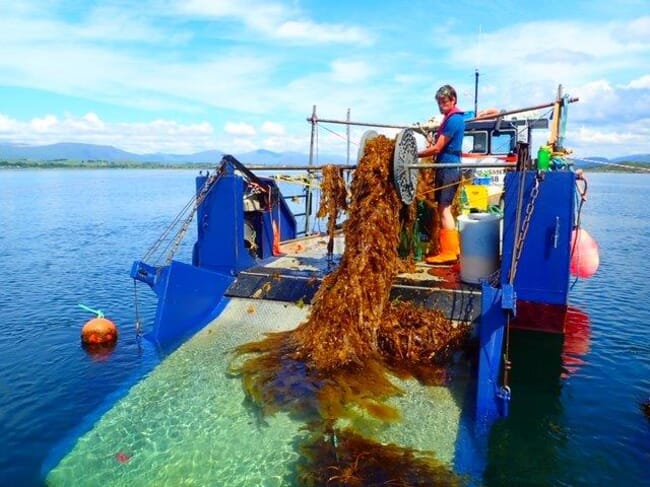
© SAMS
The review found that Scotland's seaweed sector currently delivers an estimated gross value added (GVA) of £510,000 and employs around 60 people, with small, artisan style businesses leading the domestic sector. However, projections estimate this figure could increase substantially by 2040. Popular as a cooking ingredient, seaweed is also used in the pharmaceutical and cosmetic industries.
The report explores two projected future growth scenarios, assessing the potential impacts of seaweed-based industries on the Scottish economy, communities and wider industries to 2040. The growth scenarios were developed for key existing product types and those most likely to develop, informed by the review of the current seaweed industry in Scotland, stakeholder consultation on aspirations for growth, raw material requirements, processing capability, constraints to sector growth and evidence of trends in market demand. Both scenarios assume that all projected sector growth including the establishment of new seaweed-related businesses occurs within Scotland.
The scenarios were:
1. Business as usual
Under this scenario, the sector would continue to grow through increased production of existing products and development of new high value products. Commercial-scale seaweed farming does not develop and raw material is supplied entirely by wild harvesting. Should this occur the report predicts that:
- The food product sector grows 5 percent per year, with one new business established each year to 2030, then one every other year to 2040.
- The bioactives product sector has 7 percent growth per year, with two new businesses established (in 2025 and 2030).
- There is no substantial growth in the animal feed sector (growth rates confidential).
- The horticulture product sector experiences high growth to 2025, then lower growth rates to 2040 (rates confidential).
- Raw material for this growth is supplied entirely by wild harvesting of seaweed in Scotland, with supply increasing to 25,000 tonnes by 2040.
This scenario is projected to generate a total turnover of £22.1 million per year by 2040, comprising £15.4 million for businesses who produce seaweed-based products and £3.3 million for their supply chain, as well as £2.9 million for seaweed production and £500,000 for their supply chain. This contributes £11.5 million in GVA per year to the economy by 2040 and a further £1.9 million once induced impacts are included. This activity is estimated to support 130 FTE jobs by 2040 and a further 30 FTE in the wider economy once induced impacts are included.
2. Higher growth
Under this scenario commercial-scale seaweed cultivation develops, providing additional raw material and enabling a higher growth of the component industry sectors. A biorefinery is developed in Scotland utilising cultivated seaweed. Should this occur, the report predicts that:
- The food sector grows 10 percent per year, with one new business established each year to 2030, then one every other year to 2040.
- The bioactives sector grows 10 percent per year, with three new business established (in 2025, 2030 and 2035).
- There is no substantial growth in the animal feed sector (growth rates confidential).
- In the horticulture sector one new business is established every 5 years (growth rates confidential).
- The biotechnology sector develops, with one biorefinery business operational by 2025 (growth rates confidential).
- Raw material required for this growth is 54,000 tonnes by 2040, with 30,000 tonnes from wild harvesting and 24,000 tonnes from cultivation.
This scenario is projected to generate a total turnover of £71.2 million per year by 2040, comprising £52.6 million for businesses who produce seaweed-based products and £10.5 million for their supply chain, as well as £3.5 million for seaweed production (wild harvesting) and £590,000 for their supply chain, and £2.8 million for businesses who are cultivating seaweed and £1.2 million for their supply chain. This contributes £38.5 million per year in GVA to the economy by 2040 and a further £6.6 million per year in GVA once induced impacts are included (to reflect additional spend by those employed directly and indirectly). Overall, this would mean total GVA of £45.1 million by 2040, which could represent 0.025 percent of Scotland’s overall GVA by 2040. This activity is estimated to support 400 FTE jobs by 2040 and a further 90 FTE in the wider economy once induced impacts are included.
Background
The mapping exercise - which can be read in full here - was undertaken by the Seaweed Review Steering Group, an organisation with representatives from the fisheries, conservation, science, biotechnology and seaweed sectors.
The new review highlights the need for comprehensive policy and robust legislation around planning and licensing of the sector to deliver environmentally sustainable development and has been welcomed by the Scottish Government.
Rural affairs secretary, Mairi Gougeon, said in a press release issued today: “I am very grateful to the Seaweed Review Steering Group for this comprehensive report.
“There is a long history of harvesting seaweed in Scotland and growing interest in the sector supports our decision to include seaweed as part of the first stage of the aquaculture review by Professor Griggs, which was published earlier this month.
“Other pieces of work, including the new seafood strategy to be published later this year, underline our commitment to ensure that existing and emerging seaweed activities fit into our broader framework for managing multiple uses of the sea, including fishing and renewable energy.”




